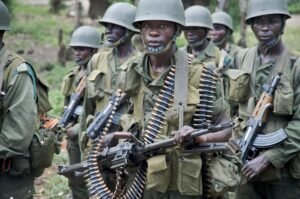The Second Congo War (1998-2003), often referred to as Africa's World War, was a devastating conflict that engulfed the Democratic Republic of Congo (DRC) and involved nine African nations and around twenty-five armed groups. This war was not just a clash of armies but a complex web of alliances, ethnic rivalries, and political maneuvers that left a lasting scar on the region.
The Genesis of the Conflict
The roots of the Second Congo War (1998-2003) can be traced back to the aftermath of the Rwandan Genocide in 1994. After the genocide, Hutu militias fled to eastern Congo, creating instability in the region. The First Congo War (1996-1997) saw the overthrow of dictator Mobutu Sese Seko by Laurent-Désiré Kabila, who was backed by Rwanda and Uganda. However, the alliance between Kabila and his backers quickly soured, setting the stage for the second and more destructive war.
The Players in the War
The Second Congo War (1998-2003) was a multi-faceted conflict with numerous parties involved:
Government Forces
- Democratic Republic of Congo: Led initially by Laurent-Désiré Kabila and later by his son, Joseph Kabila, after Laurent’s assassination in 2001.
Rebel Groups
- Rwandan-backed Rassemblement Congolais pour la Démocratie (RCD)
- Ugandan-backed Movement for the Liberation of Congo (MLC)
Foreign Nations Involved
- Rwanda: Motivated by security concerns and economic interests.
- Uganda: Similarly driven by security and economic factors.
- Angola, Namibia, and Zimbabwe: These countries supported Kabila’s government, partly to counterbalance Rwanda and Uganda’s influence.
Other Armed Groups
- Numerous local militias and ethnic groups, such as the Mai-Mai and the Interahamwe, further complicated the conflict.
Major Battlegrounds and Flashpoints
The Second Congo War (1998-2003) spanned vast areas of the DRC, making it difficult to pinpoint every significant battleground. However, several key locations stood out due to their strategic importance and the intensity of the fighting.
Kisangani
A major city in northeastern Congo, Kisangani saw repeated clashes between Ugandan and Rwandan forces, even though they were initially allies.
Bunia
Located in the Ituri region, Bunia was a hotspot of ethnic violence, particularly between the Hema and Lendu groups.
Goma
This city served as a key base for Rwandan-backed forces and was a central hub in the conflict.
Kinshasa
While relatively far from the eastern frontlines, the capital Kinshasa experienced significant political turmoil and violence.
Humanitarian Crisis and Aftermath

The Second Congo War (1998-2003) is often remembered for the staggering humanitarian crisis it created. With over 5 million people dead, mostly from starvation and disease rather than direct combat, it was one of the deadliest conflicts since World War II. The war also displaced millions, leading to a refugee crisis that spilled over into neighboring countries.
Economic and Environmental Impact
The war devastated the DRC’s already fragile economy. Infrastructure was destroyed, agricultural production plummeted, and the country’s rich mineral resources were plundered by various factions. The environmental impact was equally severe, with vast tracts of forest damaged and wildlife populations decimated due to uncontrolled exploitation and warfare.
Efforts Towards Peace
Bringing an end to the Second Congo War (1998-2003) was no simple task. Numerous peace talks and agreements were attempted, but most were short-lived. It wasn’t until the signing of the Pretoria Accord in 2002 and the Sun City Agreement in 2003 that a semblance of peace was restored.
Pretoria Accord
This agreement, signed in July 2002, between the DRC and Rwanda, stipulated the withdrawal of Rwandan troops in exchange for the disarmament of Hutu militias in Congo.
Sun City Agreement
The 2003 accord was a power-sharing deal that established a transitional government, incorporating various rebel factions and the government, paving the way for elections.
Lingering Effects and Continued Struggles
Despite the official end of the Second Congo War (1998-2003), the DRC has continued to experience violence and instability. Armed groups still operate in the eastern regions, and the country struggles with political corruption, weak governance, and economic challenges.
Conclusion
The Second Congo War (1998-2003) stands as a tragic chapter in African history, illustrating the devastating consequences of regional conflicts and international meddling. While peace agreements have brought some stability, the DRC continues to grapple with the war's aftermath. Understanding this conflict is crucial not only for grasping the DRC's current challenges but also for appreciating the broader implications for peace and stability in Africa.
Frequently Asked Questions
What caused the Second Congo War?
The war was triggered by a complex mix of ethnic tensions, the aftermath of the Rwandan Genocide, regional power struggles, and economic interests, particularly in the DRC's vast mineral wealth.
Who were the main parties involved in the war?
The main parties included the DRC government, various rebel groups like the RCD and MLC, and foreign nations such as Rwanda, Uganda, Angola, Namibia, and Zimbabwe.
What were the main consequences of the war?
The war resulted in over 5 million deaths, widespread displacement, a severe humanitarian crisis, economic devastation, and significant environmental damage.
How did the Second Congo War end?
The war officially ended with the signing of the Pretoria Accord in 2002 and the Sun City Agreement in 2003, which established a transitional government.
Is the DRC still affected by the war today?
Yes, the DRC continues to face violence, particularly in its eastern regions, as well as ongoing political and economic challenges stemming from the war.


